Lagomorpha
The lagomorphs are the members of the taxonomic order Lagomorpha, of which there are two living families: the Leporidae (hares and rabbits) and the Ochotonidae (pikas). The name of the order is derived from the Ancient Greek lagos (λαγώς, "hare") + morphē (μορφή, "form"). There are ninety-one extant species of lagomorph, including thirty species of pika, twenty-nine species of rabbit and cottontail, and thirty-two species of hare.[3]
| Lagomorphs[1] | |
|---|---|
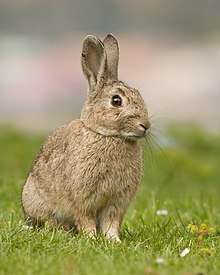 | |
| European rabbit (Oryctolagus cuniculus) | |
| Scientific classification | |
| Kingdom: | Animalia |
| Phylum: | Chordata |
| Class: | Mammalia |
| Clade: | Exafroplacentalia |
| Magnorder: | Boreoeutheria |
| Superorder: | Euarchontoglires |
| (unranked): | Glires |
| Order: | Lagomorpha Brandt, 1855 |
| Families | |
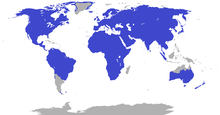 | |
| Range of Lagomorpha | |
Taxonomy and evolutionary history
Other names used for this order, now considered synonymous, include: Duplicidentata - Illiger, 1811; Leporida - Averianov, 1999; Neolagomorpha - Averianov, 1999; Ochotonida - Averianov, 1999; and Palarodentia - Haeckel, 1895, Lilian, 2016.[1]
The evolutionary history of the lagomorphs is still not well understood. Until recently, it was generally agreed that Eurymylus, which lived in eastern Asia and dates back to the late Paleocene or early Eocene, was an ancestor of the lagomorphs.[4] More recent examination of the fossil evidence suggests that the lagomorphs may have instead descended from Anagaloidea, also known as "mimotonids", while Eurymylus was more closely related to rodents (although not a direct ancestor).[5] The leporids first appeared in the late Eocene and rapidly spread throughout the Northern Hemisphere; they show a trend towards increasingly long hind limbs as the modern leaping gait developed. The pikas appeared somewhat later in the Oligocene of eastern Asia.[6]
Lagomorphs were certainly more diverse in the past than in the present, with around 75 genera and over 230 species represented in the fossil record and many more species in a single biome. This is evidence that lagomorph lineages are declining.[7]
Recent finds suggest an Indian origin for the clade, having possibly evolved in isolation when India was an island continent in the Paleocene.[8]
Characteristics
Lagomorphs are similar to other mammals in that they all have hair, four limbs (i.e., they are tetrapods), and mammary glands and are endotherms. Lagomorphs possess a moderately fused post orbital process to the cranium, unlike other small mammals.[9] They differ in that they have a mixture of "primitive" and "advanced" physical traits.
Differences between lagomorphs and other mammals
Despite the evolutionary relationship between lagomorphs and rodents, the two orders have some major differences. One of the ways in which lagomorphs differ from rodents is that the former have four incisors in the upper jaw (not two, as in the Rodentia). Also, lagomorphs are almost strictly herbivorous, unlike rodents, many of which will eat both meat and vegetable matter. They are similar to rodents in that their incisor teeth grow continuously throughout their lives, thus necessitating constant chewing on fibrous food to prevent the teeth from growing too long.[10][11] Lagomorphs and rodents form the clade or grandorder Glires.
Similarly to the rodents, bats, and some mammalian insectivores, they have a smooth-surfaced cerebrum.[12]
Differences between families of lagomorphs
Rabbits and hares move by jumping, pushing off with their strong hind legs and using their forelimbs to soften the impact on landing. Pikas lack certain skeletal modifications present in leporids, such as a highly arched skull, an upright posture of the head, strong hind limbs and pelvic girdle, and long limbs.[13] Also, pikas have a short nasal region and entirely lack a supraorbital foramen, while leporids have prominent supraorbital foramina and nasal regions.[14]
Pikas

Pikas, also known as conies,[15] are entirely represented by the family Ochotonidae and are small mammals native to mountainous regions of western North America, and Central Asia. They are mostly about 15 cm (6 in) long and have greyish-brown, silky fur, small rounded ears, and almost no tail. Their four legs are nearly equal in length. Some species live in scree, making their homes in the crevices between broken rocks, while others construct burrows in upland areas. The rock-dwelling species are typically long-lived and solitary, have one or two litters of a small number of young each year and have stable populations. The burrowing species, in contrast, are short-lived, gregarious and have multiple large litters during the year. These species tend to have large swings in population size. The gestation period of the pika is around one month long, and the newborns are altricial– they require parental care.[16] The social behaviour of the two groups also differs: the rock dwellers aggressively maintain scent-marked territories, while the burrowers live in family groups, interact vocally with each other and defend a mutual territory. Pikas are diurnal and are active early and late in the day during hot weather. They feed on all sorts of plant material. As they do not hibernate, they make "haypiles" of dried vegetation which they collect and carry back to their homes to store for use during winter.[13]
Hares
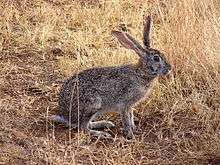
Hares, members of genus Lepus of family Leporidae, are medium size mammals native to Europe, Asia, Africa, and North America. North American jackrabbits are actually hares. Species vary in size from 40 to 70 cm (16 to 28 in) in length and have long powerful back legs, and ears up to 20 cm (8 in) in length. Although usually greyish-brown, some species turn white in winter. They are solitary animals and several litters of young are born during the year in a form, a hollow in the ground amongst dense vegetation. The young are born fully furred and active. They are preyed upon by large mammalian carnivores and birds of prey.[17]
Rabbits
Rabbits, members of family Leporidae outside Lepus, are generally much smaller than hares and include the rock hares and the hispid hare. They are native to Europe, parts of Africa, Central and Southern Asia, North America and much of South America. They inhabit both grassland and arid regions. They vary in size from 20 to 50 cm (8 to 20 in) and have long, powerful hind legs, shorter forelegs and a tiny tail. The colour is some shade of brown, buff or grey and there is one black species and two striped ones. Domesticated rabbits come in a wider variety of colours. Newborn rabbits are less developed than hares and require parental care. Although most species live and breed in burrows, the cottontails and hispid hares have forms (nests). Most of the burrowing species are colonial, and may feed together in small groups. Rabbits play an important part in the terrestrial food chain, eating a wide range of forbs, grasses, and herbs, and being part of the staple diet of many carnivorous species. Many breeds of rabbit can be litter-trained, and—assuming they are given sufficient room to run—can live happy lives as house pets.
Distribution
Lagomorphs are widespread around the world and inhabit every continent except Antarctica. However, they are not found in most of the southern cone of South America, in the West Indies, Indonesia or Madagascar, nor on many islands. Although they are not native to Australia, humans have introduced them there and they have successfully colonized many parts of the country and caused disruption to native species.[18]
Biology
Digestion
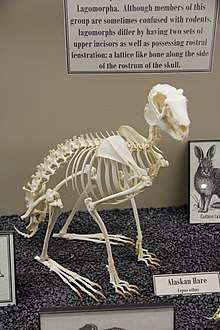
Like other herbivores, lagomorphs have to deal with a bulky diet in which the cell walls are composed of cellulose, a substance which mammalian digestive enzymes are unable to break down. Despite this, lagomorphs have developed a way of extracting maximum nourishment from their diet. First they bite off and shred plant tissues with their incisors and then they grind the material with their molars. Digestion continues in the stomach and small intestine where nutrients are absorbed. After that, certain food remains get diverted into the caecum, a blind-ended pouch. Here, they are mixed with bacteria, yeasts and other micro-organisms that are able to digest cellulose and turn it into sugar, a process known as hindgut fermentation. Other faecal matter passes along the colon and is excreted in the normal way as small, dry pellets. About four to eight hours after the meal, the contents of the caecum pass into the colon and are eliminated as soft, moist pellets known as cecotropes. These are immediately eaten by the lagomorph, which can thus extract all the remaining nutrients in the food.[19]
Birth and early life
Many lagomorphs breed several times a year and produce large litters. This is particularly the case in species that breed in underground, protective environments such as burrows. The altricial young of rabbits, called kittens, are born naked and helpless after a short gestation period and the mother can become pregnant again almost immediately after giving birth. The mothers are able to leave these young safely and go off to feed, returning at intervals to feed them with their unusually rich milk. In some species, the mother only visits and feeds the litter once a day but the young grow rapidly and are usually weaned within a month. Hares live above ground and their litters, containing leverets, are born in "forms" concealed among tussocks and scrub. They have a strategy to prevent predators from tracking down their litter by following the adults' scent. They approach and depart from the nesting site in a series of immense bounds, sometimes moving at right angles to their previous direction.[20] The young are precocial and a small number are born after a longer gestation period, already clad in short fur and able to move around.[11]
Sociality and safety
Many species of lagomorphs, particularly the rabbits and the pikas, are gregarious and live in colonies, whereas hares are generally solitary species, although many hares travel and forage in groups of two, three, or four. The rabbits and pikas rely on their holes as places of safety when danger threatens, but hares rely on their long legs, great speed and jinking gait to escape from predators.
Classification

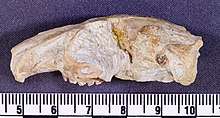
- Order Lagomorpha Brandt 1885[1][21]
- Family Leporidae Fischer de Waldheim 1817 (rabbits and hares)
- Subfamily † Archaeolaginae
- Genus †Archaeolagus Dice 1917
- Genus †Hypolagus Dice 1917
- Genus †Notolagus Wilson 1938
- Genus †Panolax Cope 1874
- Subfamily Leporinae Trouessart 1880
- Genus †Alilepus Dice 1931
- Genus Brachylagus
- Genus Bunolagus
- Genus Caprolagus Blyth 1845
- Genus Lepus Linnaeus 1758
- Genus Nesolagus Forsyth Major 1899
- Genus Oryctolagus Lilljeborg 1874
- Genus †Nuralagus Lilljeborg 1874
- Genus Pentalagus Lyon 1904
- Genus †Pliolagus Kormos 1934
- Genus †Pliosiwalagus Patnaik 2001
- Genus Poelagus
- Genus †Pratilepus Hibbard 1939
- Genus Pronolagus Lyon 1904
- Genus Romerolagus Merriam 1896
- Genus †Serengetilagus Dietrich 1941
- Genus Sylvilagus Gray 1867
- Subfamily †Palaeolaginae Dice 1929
- Tribe †Dasyporcina Gray 1825
- Genus †Coelogenys Illiger 1811
- Genus †Agispelagus Argyropulo 1939
- Genus †Aluralagus Downey 1968
- Genus †Austrolagomys Stromer 1926
- Genus †Aztlanolagus Russell & Harris 1986
- Genus †Chadrolagus Gawne 1978
- Genus †Gobiolagus Burke 1941
- Genus †Lagotherium Pictet 1853
- Genus †Lepoides White 1988
- Genus †Nekrolagus Hibbard 1939
- Genus †Ordolagus de Muizon 1977
- Genus †Paranotolagus Miller & Carranza-Castaneda 1982
- Genus †Pewelagus White 1984
- Genus †Pliopentalagus Gureev & Konkova 1964
- Genus †Pronotolagus White 1991
- Genus †Tachylagus Storer 1992
- Genus †Trischizolagus Radulesco & Samson 1967
- Genus †Veterilepus Radulesco & Samson 1967
- Tribe incertae sedis
- Genus †Litolagus Dawson 1958
- Genus †Megalagus Walker 1931
- Genus †Mytonolagus Burke 1934
- Genus †Palaeolagus Leidy 1856
- Tribe †Dasyporcina Gray 1825
- Subfamily † Archaeolaginae
- Family Ochotonidae Thomas 1897 (pikas)
- Genus †Alloptox Dawson 1961
- Genus †Amphilagus Tobien 1974
- Genus †Bellatona Dawson 1961
- Genus †Cuyamalagus Hutchison & Lindsay 1974
- Genus †Desmatolagus Matthew & Granger 1923
- Genus †Gripholagomys Green 1972
- Genus †Hesperolagomys Clark et al. 1964
- Genus †Kenyalagomys MacInnes 1953
- Genus †Lagopsis Schlosser 1894
- Genus Ochotona Link 1795
- Genus †Ochotonoides Teilhard de Jardin & Young 1931
- Genus †Ochotonoma Sen 1998
- Genus †Oklahomalagus Dalquest et al. 1996
- Genus †Oreolagus Dice 1917
- Genus †Piezodus Viret 1929
- Genus †Russellagus Storer 1970
- Genus †Sinolagomys Bohlin 1937
- Genus †Titanomys von Meyer 1843
- Family †Prolagidae Gureev, 1962 (Sardinian pika and other related extinct pika-like lagomorphs)
- Genus †Prolagus Pomel 1853
- Family incertae sedis
- Genus †Eurolagus Lopez Martinez 1977
- Genus †Hsiuannania Xu 1976
- Genus †Hypsimylus Zhai 1977
- Genus †Lushilagus Li 1965
- Genus †Shamolagus Burke 1941
- Family Leporidae Fischer de Waldheim 1817 (rabbits and hares)
References
- Hoffman, R.S.; Smith, A.T. (2005). "Order Lagomorpha". In Wilson, D.E.; Reeder, D.M (eds.). Mammal Species of the World: A Taxonomic and Geographic Reference (3rd ed.). Johns Hopkins University Press. pp. 185–211. ISBN 978-0-8018-8221-0. OCLC 62265494.
- Ge, Deyan; Wen, Zhixin; Xia, Lin; Zhang, Zhaoqun; Erbajeva, Margarita; Huang, Chengming; Yang, Qisen (April 3, 2013). "Evolutionary History of Lagomorphs in Response to Global Environmental Change". PLOS One. 8 (4:e59668): e59668. Bibcode:2013PLoSO...859668G. doi:10.1371/journal.pone.0059668. PMC 3616043. PMID 23573205.
- "lagomorph | mammal". Retrieved 2015-08-15.
- Palmer, D., ed. (1999). The Marshall Illustrated Encyclopedia of Dinosaurs and Prehistoric Animals. London: Marshall Editions. p. 285. ISBN 1-84028-152-9.
- Rose, Kenneth David (2006). The Beginning of the Age of Mammals. The Johns Hopkins University Press. p. 315. ISBN 0-8018-8472-1.
- Savage, RJG, & Long, MR (1986). Mammal Evolution: an illustrated guide. New York: Facts on File. pp. 128–129. ISBN 0-8160-1194-X.CS1 maint: multiple names: authors list (link)
- Lagomorph Biology: Evolution, Ecology, and Conservation.
- Rose K.D., Deleon V.B., Mmissian P., Rana R.S., Sahni A., Singh L. & Smith T. (2008). – Early Eocene lagomorph (Mammalia) from western India and the early diversification of Lagomorpha. – Proc. Royal Society B, RSPB 2007.1661.R1
- Wible, John R. (January 2007). "On the Cranial Osteology of the Lagomorpha". Bulletin of Carnegie Museum of Natural History. 2007 (39): 213–234. doi:10.2992/0145-9058(2007)39[213:OTCOOT]2.0.CO;2. ISSN 0145-9058.
- Best, T. L., Henry, T. H. (1994-06-02). "Lepus arcticus". Mammalian Species. 457 (457): 1–9. doi:10.2307/3504088. ISSN 0076-3519. JSTOR 3504088. OCLC 46381503.CS1 maint: multiple names: authors list (link)
- Smith, Andrew T. "Lagomorph". Encyclopædia Britannica. Retrieved 2013-08-13.
- Ferrer, I., Fabregues, I. & Condom, E. (1986). "A Golgi study of the sixth layer of the cerebral cortex I: The lissencephalic brain of Rodentia, Lagomorpha, Chiroptera, and Insectivora" (PDF). Journal of Anatomy. 145: 217–234. PMC 1166506. PMID 3429306.CS1 maint: multiple names: authors list (link)
- Smith, Andrew T. "Pika". Encyclopædia Britannica. Retrieved 2013-08-15.
- "IUCN - Lagomorph specialist group". www.iucn.org. Archived from the original on 2015-08-03. Retrieved 2015-08-18.
- "Lagomorphs - EnchantedLearning.com". www.enchantedlearning.com. Retrieved 2015-08-15.
- "American Pika | National Wildlife Federation". National Wildlife Federation. Retrieved 2018-11-19.
- Smith, Andrew T. "Hare". Encyclopædia Britannica. Retrieved 2013-08-15.
- Klappenbach, Laura. "Hares, Rabbits and Pikas". About.com. Retrieved 2013-08-14.
- "Exploring a Rabbit's Unique Digestive System". Rabbits for Dummies. Retrieved 2013-08-14.
- Burton, Maurice (1971). The Observer's Book of British Wild Animals. Frederick Warne & Co. pp. 109–112. ISBN 9780723215035.
- The Paleobiology Database Lagomorpha entry Accessed on 13 May 2010
